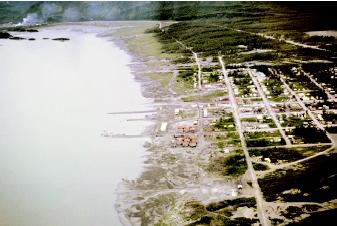Tsunamis
A tsunami is a powerful wave, usually created by a large-scale motion of the ocean floor. Although they are almost imperceptible at sea, tsunami waves increase in height as they reach a coastline and are capable of causing great destruction. The term "tsunami" is taken from the Japanese words for "harbor" and "wave."
In the 1990s, eighty-two tsunamis were reported worldwide, taking more than four thousand lives and causing hundreds of millions of dollars in damage. Most tsunamis occur in seismically active regions such as the Pacific Ocean, but tsunamis can occur anywhere in the world where there are large bodies of water.

Mechanics of Tsunami Generation and Propagation
A tsunami can be caused by any disturbance that moves a large amount of water. The vast majority of tsunamis originate during undersea earthquakes when water is moved by the uplift or subsidence of hundreds of square kilometers of the sea floor. Landslides (which often accompany large earthquakes), volcanic eruptions and collapses, and explosions and meteor impacts can also disturb enough water to generate a tsunami.
Propagation.
The wind-generated waves usually seen breaking on the beach arrive every 10 to 15 seconds and have wave crests tens of meters apart. In contrast, tsunamis can have crests that are more than 20 minutes and hundreds of kilometers apart (see figure).
Most tsunamis are classified as long waves—that is, waves with long wavelengths relative to their water depth. They travel with speeds proportional to the square root of the water depth. In the deep ocean, their speed can be similar to that of a jet plane, as high as 700 kilometers per hour. Closer to shore, in shallow water, they slow down appreciably. At sea, the height of a tsunami wave is not usually distinguishable from the surrounding wind waves without sensitive measuring equipment because the wave often is only 1 to 2 meters high and hundreds of kilometers long.
Tsunamis generated by earthquake movement of the seabed can travel thousands of miles across the ocean without losing their energy. For example, in 1960 a tsunami generated in Chile, South America caused substantial damage nearly 14,500 kilometers (9,000 miles) away in Japan. Hawaii, in the middle of the Pacific Ocean, is particularly susceptible to tsunamis that travel across the ocean.
Unlike earthquake-caused waves, tsunamis generated by mechanisms like landslides and eruptions dissipate quickly and rarely affect coastlines far away from the source. Their local effects, however, can sometimes be just as damaging: in 1883, the tsunami caused by the eruption of the volcano Krakatau killed more than 36,000 people on the nearby islands of Java and Sumatra.
Landfall.
As tsunami waves approach the coastline, a large change takes place in their shape. Since the landward portion of the wave is in shallower water than the seaward portion, it travels relatively slower. This allows rear

When a tsunami reaches the shore, the impact can destroy buildings and other coastal structures. The flowing water can move boats, vehicles and debris. Further destruction results when these objects collide like battering rams with anything in their path. Gas lines broken during the tsunami often cause fires that increase the tsunami damage. Tsunamis can flood low-lying areas, destroying crops with salt water and leaving behind sand and boulders.
Mitigation and Research
Efforts to protect people from tsunamis center on proper preparation of tsunami-prone areas. Many lives have been saved when residents of coastal communities were aware that earthquake shaking was a signal to evacuate to high ground.
Although certain tsunamis, such as those generated by landslides, arrive without warning, tsunami researchers are focusing on better predicting these locally destructive waves as well as the transoceanic ones. The tools that researchers use include seismic stations, deep-ocean pressure gauges, and physical and numerical models. Field surveys of recent tsunamis and geological investigations of ancient waves also help scientists and hazards planners design structures and plan communities so that casualties and damage can be reduced.
SEE ALSO Human Health and the Ocean ; Landslides ; Waves .
Catherine M. Petroff
Bibliography
Folger, T. "Killer Waves, the Struggle to Predict Tsunamis." Discover Magazine May 1994, 66–73.
Gonzalez, F. "Tsunami, Predicting Destruction by Monster Waves." Scientific American May 1999, 56–65.
McCredie, S. "Tsunamis, the Waves that Kill." Smithsonian Magazine March 1994, 28–39.
Internet Resources
Tsunami! University of Washington. <http://www.geophys.washington.edu/tsunami> .
USC Tsunami Research Group. University of Southern California. <http://www.usc.edu/dept/tsunamis> .
Tsunami Research Program. National Oceanic and Atmospheric Association. <http://www.pmel.noaa.gov/tsunami> .
TSUNAMIS ARE NOT TIDAL WAVES
At one time, tsunamis were called tidal waves for the way that the water flowed on and offshore like a quickly rising and falling tide. But because tsunamis are not caused by the gravitational pull of the Moon and Sun, the term tidal wave is no longer used.
SEA OF JAPAN: 1993
A 7.8-magnitude earthquake in the Sea of Japan caused waves 5 to 10 meters high that swept up buildings and vehicles on the island of Okushiri. Although 239 people died from the Okushiri tsunami, many residents saved themselves by fleeing to high ground immediately after the earthquake.
Comment about this article, ask questions, or add new information about this topic: